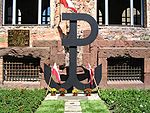
Kotwica
Encyclopedia

World War II
World War II, or the Second World War , was a global conflict lasting from 1939 to 1945, involving most of the world's nations—including all of the great powers—eventually forming two opposing military alliances: the Allies and the Axis...
emblem of the Polish Secret State
Polish Secret State
The Polish Underground State is a collective term for the World War II underground resistance organizations in Poland, both military and civilian, that remained loyal to the Polish Government in Exile in London. The first elements of the Underground State were put in place in the final days of the...
and Armia Krajowa
Armia Krajowa
The Armia Krajowa , or Home Army, was the dominant Polish resistance movement in World War II German-occupied Poland. It was formed in February 1942 from the Związek Walki Zbrojnej . Over the next two years, it absorbed most other Polish underground forces...
(Home Army, or AK). It was created in 1942 by members of the AK Wawer
Wawer
Wawer is one of the districts of Warsaw, located in the south-eastern part of the city. The Vistula river runs along its western border. Wawer became a district of Warsaw on October 27, 2002 .Wawer borders Praga Południe and Rembertów from the north, Wesoła from the east and Wilanów with Mokotów...
"Small Sabotage" unit as an easily usable emblem for the Polish struggle to regain independence. The initial meaning of the initials "PW" was "Pomścimy Wawer" ("We will avenge Wawer"). The Wawer massacre
Wawer massacre
The Wawer massacre refers to the execution of 107 Polish civilians on the night of 26 to 27 December 1939 by the Nazi German occupiers of Wawer , Poland. The execution was a response to the deaths of two German NCOs...
was considered to be one of the first large scale massacres of Polish civilians by Nazi Germany in occupied Poland. At first, Polish scouts from sabotage
Sabotage
Sabotage is a deliberate action aimed at weakening another entity through subversion, obstruction, disruption, or destruction. In a workplace setting, sabotage is the conscious withdrawal of efficiency generally directed at causing some change in workplace conditions. One who engages in sabotage is...
groups painted the whole phrase upon walls. However, this was soon shortened to two letters, P and W, due to time constraints.
The P and W initials evolved into the Kotwica (Anchor) - a combination of the letters which was easy and fast to paint. The Kotwica began to signify more than just its intended abbreviation, taking on more meanings such as Polska Walcząca ("Fighting Poland"), Wojsko Polskie ("Polish Army") and Powstanie Warszawskie ("Warsaw Uprising
Warsaw Uprising
The Warsaw Uprising was a major World War II operation by the Polish resistance Home Army , to liberate Warsaw from Nazi Germany. The rebellion was timed to coincide with the Soviet Union's Red Army approaching the eastern suburbs of the city and the retreat of German forces...
"). Eventually, the Kotwica became a patriotic symbol of defiance against occupiers and was painted in a graffiti
Graffiti
Graffiti is the name for images or lettering scratched, scrawled, painted or marked in any manner on property....
style on building walls.
The Kotwica was first painted on walls in Warsaw
Warsaw
Warsaw is the capital and largest city of Poland. It is located on the Vistula River, roughly from the Baltic Sea and from the Carpathian Mountains. Its population in 2010 was estimated at 1,716,855 residents with a greater metropolitan area of 2,631,902 residents, making Warsaw the 10th most...
, as a psychological-warfare
Psychological warfare
Psychological warfare , or the basic aspects of modern psychological operations , have been known by many other names or terms, including Psy Ops, Political Warfare, “Hearts and Minds,” and Propaganda...
tactic against the occupying Germans, by Polish boy scouts
Zwiazek Harcerstwa Polskiego
Związek Harcerstwa Polskiego is the coeducational Polish Scouting organization recognized by the World Organization of the Scout Movement and the World Association of Girl Guides and Girl Scouts. It was founded in 1918 and currently is the largest Scouting organization in Poland...
on March 20, 1942. On June 27, 1942, a new tradition was born: to commemorate the patron saint's day of the Polish President Władysław Raczkiewicz and the Commander-in-Chief
Commander-in-Chief
A commander-in-chief is the commander of a nation's military forces or significant element of those forces. In the latter case, the force element may be defined as those forces within a particular region or those forces which are associated by function. As a practical term it refers to the military...
Władysław Sikorski, members of the Armia Krajowa
Armia Krajowa
The Armia Krajowa , or Home Army, was the dominant Polish resistance movement in World War II German-occupied Poland. It was formed in February 1942 from the Związek Walki Zbrojnej . Over the next two years, it absorbed most other Polish underground forces...
stamped several hundred copies of the German-backed propaganda
Propaganda
Propaganda is a form of communication that is aimed at influencing the attitude of a community toward some cause or position so as to benefit oneself or one's group....
newspaper
Newspaper
A newspaper is a scheduled publication containing news of current events, informative articles, diverse features and advertising. It usually is printed on relatively inexpensive, low-grade paper such as newsprint. By 2007, there were 6580 daily newspapers in the world selling 395 million copies a...
, Nowy Kurier Warszawski
Nowy Kurier Warszawski
Nowy Kurier Warszawski was a German propaganda newspaper issued in the occupied Poland during World War II. Its name was coined after a popular pre-war newspaper Kurier Warszawski, with which it had nothing to do but the name...
(The New Warsaw Courier), with the Kotwica. In its first year only 500 copies were stamped with emblem but this number grew to 7,000 the following year.
On February 18, 1943, the Armia Krajowa's commander, General Stefan Rowecki
Stefan Rowecki
Stefan Paweł Rowecki was a Polish general, journalist and the leader of the Armia Krajowa. He was murdered by the Gestapo in prison, probably on the direct order of Heinrich Himmler.-Life:Rowecki was born in Piotrków Trybunalski...
, issued an order specifying that all sabotage
Sabotage
Sabotage is a deliberate action aimed at weakening another entity through subversion, obstruction, disruption, or destruction. In a workplace setting, sabotage is the conscious withdrawal of efficiency generally directed at causing some change in workplace conditions. One who engages in sabotage is...
, partisan
Partisan (military)
A partisan is a member of an irregular military force formed to oppose control of an area by a foreign power or by an army of occupation by some kind of insurgent activity...
and terrorist
Terrorism
Terrorism is the systematic use of terror, especially as a means of coercion. In the international community, however, terrorism has no universally agreed, legally binding, criminal law definition...
actions be signed with the Kotwica. On February 25, the official organ of the Armia Krajowa, Biuletyn Informacyjny
Biuletyn Informacyjny
Biuletyn Informacyjny was a Polish weekly published covertly in occupied Poland during World War II.It was started in November 1939 in Warsaw as the main press release of the SZP, the first underground resistance organisation in Poland. Soon it was taken over by the Armia Krajowa and the Bureau of...
, called the Kotwica "the sign of the underground Polish Army". Soon the symbol gained enormous popularity and became recognized by most Poles. During the later stages of the war, most of the political and military organizations in Poland (even those not related to the Armia Krajowa) adopted it as their symbol. It was painted on the walls of Polish cities, stamped on German banknote
Banknote
A banknote is a kind of negotiable instrument, a promissory note made by a bank payable to the bearer on demand, used as money, and in many jurisdictions is legal tender. In addition to coins, banknotes make up the cash or bearer forms of all modern fiat money...
s and post stamps, printed in the headers of underground newspapers and books, and it became one of the symbols of the Warsaw Uprising
Warsaw Uprising
The Warsaw Uprising was a major World War II operation by the Polish resistance Home Army , to liberate Warsaw from Nazi Germany. The rebellion was timed to coincide with the Soviet Union's Red Army approaching the eastern suburbs of the city and the retreat of German forces...
.
After World War II
World War II
World War II, or the Second World War , was a global conflict lasting from 1939 to 1945, involving most of the world's nations—including all of the great powers—eventually forming two opposing military alliances: the Allies and the Axis...
, Poland's communist authorities banned the Kotwica. Used by most associations of former Armia Krajowa members in exile
Exile
Exile means to be away from one's home , while either being explicitly refused permission to return and/or being threatened with imprisonment or death upon return...
, it was strictly prohibited in Poland. As the communist grip weakened, the symbol was no longer censored, and in 1976 it became one of the symbols of Ruch Obrony Praw Człowieka i Obywatela (ROPCiO), an anti-communist organization defending human rights
Human rights
Human rights are "commonly understood as inalienable fundamental rights to which a person is inherently entitled simply because she or he is a human being." Human rights are thus conceived as universal and egalitarian . These rights may exist as natural rights or as legal rights, in both national...
in Poland. Later it was also adopted by various other anti-communist political organizations, ranging from the rightist Konfederacja Polski Niepodleglej (KPN) of Leszek Moczulski
Leszek Moczulski
Leszek Moczulski is a Polish historian and politician, a member of various organizations opposing the communist regime in the People's Republic of Poland and the co-founder of the first non-communist and not-underground political party in the Eastern Bloc....
to the Solidarność Walcząca
Fighting Solidarity
Fighting Solidarity was a Polish anti-communist underground organization, founded in 1982 by Kornel Morawiecki in Wrocław in response to the delegalization of Solidarity and government repression of the opposition after martial law was declared in 1981...
(Fighting Solidarity).
See also
- Cross of LorraineCross of LorraineThe Cross of Lorraine is originally a heraldic cross. The two-barred cross consists of a vertical line crossed by two smaller horizontal bars. In the ancient version, both bars were of the same length. In 20th century use it is "graded" with the upper bar being the shortest...
- symbol of the Free French - H7H7 (monogram)H7 was the monogram of the Norwegian head of state, King Haakon VII , who reigned from 1905 to 1957. When Germany invaded Norway in 1940 as a part of World War II, the royal family fled the country, and Haakon VII later spearheaded the Norwegian resistance in exile in the United Kingdom...
- symbol of Haakon VII of NorwayHaakon VII of NorwayHaakon VII , known as Prince Carl of Denmark until 1905, was the first king of Norway after the 1905 dissolution of the personal union with Sweden. He was a member of the House of Schleswig-Holstein-Sonderburg-Glücksburg...
Further reading
- Lesław J. Welker "Symbolika znaków Polski Walczącej", publisher Adam Marszałek ISBN 83-7174-498-6, ISBN 83-7322-090-9, EAN: 9788373220904
- Jan Bijata, Wawer, Książka i Wiedza, Warszawa 1973
External links
- History of the Kotwica (in Polish)
- Article about the "Small sabotage" unit (in Polish)

